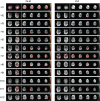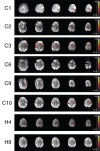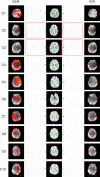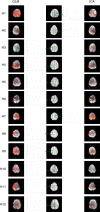Applying independent component analysis to clinical FMRI at 7 t
- PMID: 24032007
- PMCID: PMC3759034
- DOI: 10.3389/fnhum.2013.00496
Applying independent component analysis to clinical FMRI at 7 t
Abstract
Increased BOLD sensitivity at 7 T offers the possibility to increase the reliability of fMRI, but ultra-high field is also associated with an increase in artifacts related to head motion, Nyquist ghosting, and parallel imaging reconstruction errors. In this study, the ability of independent component analysis (ICA) to separate activation from these artifacts was assessed in a 7 T study of neurological patients performing chin and hand motor tasks. ICA was able to isolate primary motor activation with negligible contamination by motion effects. The results of General Linear Model (GLM) analysis of these data were, in contrast, heavily contaminated by motion. Secondary motor areas, basal ganglia, and thalamus involvement were apparent in ICA results, but there was low capability to isolate activation in the same brain regions in the GLM analysis, indicating that ICA was more sensitive as well as more specific. A method was developed to simplify the assessment of the large number of independent components. Task-related activation components could be automatically identified via these intuitive and effective features. These findings demonstrate that ICA is a practical and sensitive analysis approach in high field fMRI studies, particularly where motion is evoked. Promising applications of ICA in clinical fMRI include presurgical planning and the study of pathologies affecting subcortical brain areas.
Keywords: artifacts; independent component analysis; motion; motor; neurology; presurgical planning; ultra-high field fMRI.
Figures









References
Grants and funding
LinkOut - more resources
Full Text Sources
Other Literature Sources
Miscellaneous

